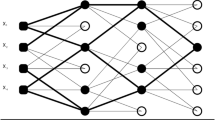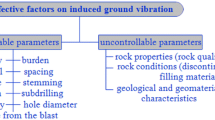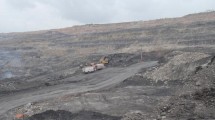Abstract
In this study, an attempt has been made to evaluate and predict the blast-induced ground vibration by incorporating explosive charge per delay and distance from the blast face to the monitoring point using artificial neural network (ANN) technique. A three-layer feed-forward back-propagation neural network with 2-5-1 architecture was trained and tested using 130 experimental and monitored blast records from the surface coal mines of Singareni Collieries Company Limited, Kothagudem, Andhra Pradesh, India. Twenty new blast data sets were used for the validation and comparison of the peak particle velocity (PPV) by ANN and conventional vibration predictors. Results were compared based on coefficient of determination and mean absolute error between monitored and predicted values of PPV.











Similar content being viewed by others
References
Ambraseys NR, Hendron AJ (1968) Dynamic behaviour of rock masses: rock mechanics in engineering practices. Wiley, London
Bureau of Indian Standard (1973) Criteria for safety and design of structures subjected to underground blast. ISI Bulletin IS-6922
Cai JG, Zhao J (1997) Use of neural networks in rock tunneling. In: Proceedings of computer methods and advances in geomechanics, IACMAG, China, pp 613–618
Dowding CH (1985) Blast vibration monitoring and control. Prentice-Hall Inc, Englewoods Cliffs
Duvall, WI, Petkof B (1959) Spherical propagation of explosion generated strain pulses in rock. USBM RI, 5483, p 21
Hagan TN (1973) Rock breakage by explosives, In: Proceedings of national symposium on rock fragmentation, Adelaide, pp 1–17
ISRM (1992) Suggested method for blast vibration monitoring. Int J Rock Mech Min Sci Geomech Abstr 29:145–146
Khandelwal M, Singh TN (2005) Prediction of blast-induced air overpressure in opencast mine. Noise Vib Worldw 36:7–16
Khandelwal M, Singh TN (2006) Prediction of blast-induced ground vibrations and frequency in opencast mine—a neural network approach. J Sound Vib 289:711–725
Khandelwal M, Singh TN (2009) Prediction of blast-induced ground vibrations using artificial neural network. Int J Rock Mech Min Sci 46:1214–1222
Khandelwal M, Singh TN (2002) Prediction of waste dump stability by an intelligent approach. In: National symposium on new equipment—new technology, management and safety, ENTMS, Bhubaneshwar, pp 38–45
Khandelwal M (2008) Evaluation and prediction of blast-induced ground vibration and frequency for surface mine—a neural network approach. Ph.D. Thesis, Indian Institute of Technology, Bombay, India
Kosko B (1994) Neural networks and fuzzy systems: a dynamical systems approach to machine intelligence. Prentice Hall, New Delhi
Langefors U, Kihlstrom B (1963) The modern technique of rock blasting. Wiley, New York
MacKay DJC (1992) Bayesian interpolation. Neural Comput 4:415–447
Maity D, Saha A (2004) Damage assessment in structure from changes in static parameters using neural networks. Sadhana 29:315–327
Maulenkamp F, Grima MA (1999) Application of neural networks for the prediction of the unconfined compressive strength (UCS) from Equotip Hardness. Int J Rock Mech Min Sci 36:29–39
Mohamed MT (2009) Artificial neural network for prediction and control of blasting vibrations in Assiut (Egypt) limestone quarry. Int J Rock Mech Min Sci 46:426–431
Monjezi M, Dehghani H (2008) Evaluation of effect of blasting pattern parameters on back break using neural networks. Int J Rock Mech Min Sci 45(8):1446–1453
Neaupane KM, Adhikari NR (2006) Prediction of tunneling-induced ground movement with the multi-layer perceptron. Int J Tunnel Undergr Space Technol 21:151–159
Pal Roy P (1993) Putting ground vibration predictors into practice. Colliery Guard 241:63–67
Simpson PK (1990) Artificial neural system—foundation, paradigm, application and implementations. Pergamon Press, New York
Singh TN, Kanchan R, Saigal K, Verma AK (2004) Prediction of P-wave velocity and anisotropic properties of rock using Artificial Neural Networks technique. J Sci Ind Res 63:32–38
Singh VK, Singh D, Singh TN (2001) Prediction of strength properties of some schistose rock. Int J Rock Mech Min Sci 38:269–284
Siskind DE, Stagg MS, Kopp, JW, Dowding CH (1980) Structure response and damage produced by ground vibration from surface mine blasting. USBM, RI, 8507, p. 74
Tawadrous AS (2006) Evaluation of artificial neural networks as a reliable tool in blast design. Int Soc Explos Eng 1:1–12
Wiss JF, Linehan PW (1978) Control of vibration and air noise from surface coal mines—III. Bureau of Mines. US Report No. OFR 103 (3)-79, p 623
Yang Y, Zhang Q (1997) Analysis for the results of point load testing with artificial neural network. In: Proceedings of computer methods and advances in geomechanics, IACMAG, China, pp 607–612
Author information
Authors and Affiliations
Corresponding author
Rights and permissions
About this article
Cite this article
Khandelwal, M., Lalit Kumar, D. & Yellishetty, M. Application of soft computing to predict blast-induced ground vibration. Engineering with Computers 27, 117–125 (2011). https://doi.org/10.1007/s00366-009-0157-y
Received:
Accepted:
Published:
Issue Date:
DOI: https://doi.org/10.1007/s00366-009-0157-y




